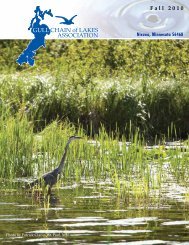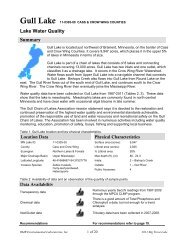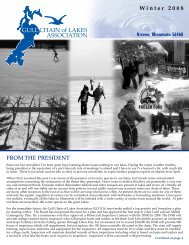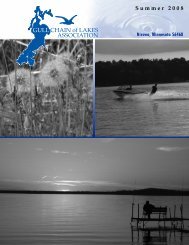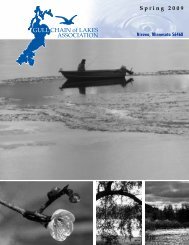Spring - Gull Chain of Lakes Association
Spring - Gull Chain of Lakes Association
Spring - Gull Chain of Lakes Association
Create successful ePaper yourself
Turn your PDF publications into a flip-book with our unique Google optimized e-Paper software.
9<br />
P R O F E S S O R P R O P O S E S<br />
I N VA S I V E S P E C I E S R E S E A R C H C E N T E R AT U O F M<br />
Source: Doug Smith, StarTribune, January 6, 2012<br />
Continued from page 8<br />
species plaguing many Minnesota’s<br />
waters. He has had some success. But<br />
the success scientists have achieved in<br />
reducing the sea lamprey, another invasive<br />
species, in the Great <strong>Lakes</strong> gives<br />
him hope that solutions can be found to<br />
control Minnesota’s waters or rid them<br />
<strong>of</strong> invasive species. Using chemicals,<br />
barriers and traps, sea lamprey numbers<br />
have fallen 90 percent since the 1950s.<br />
Meanwhile, the invasive species will do<br />
a lot <strong>of</strong> damage in Minnesota, Sorensen<br />
said. Zebra mussels could alter<br />
ecosystems, affecting game fish. And<br />
more invaders are on their way,<br />
including the northern snakehead fish<br />
— sometimes called the “Frankenfish”<br />
because it is voracious, grows up to 3 feet<br />
and can survive several days out <strong>of</strong> water.<br />
“Conventional approaches don’t work,’’<br />
Sorensen said. “It’s time to get serious<br />
about this.’’<br />
DNR sees merit<br />
A research center could potentially<br />
develop poisons, parasites or even<br />
genetically engineered diseases that<br />
would attack the invasive species.<br />
Steve Hirsch, Department <strong>of</strong> Natural<br />
Resources director <strong>of</strong> ecological and<br />
water services, said Sorensen’s proposal<br />
has merit. The DNR would work closely<br />
with a research center.<br />
“This would have nationwide<br />
significance,’’ Hirsch said. He said that<br />
some invasive species research is being<br />
undertaken elsewhere but that doing<br />
more locally likely would be beneficial.<br />
He agreed with Sorensen that deterrent<br />
barriers aren’t 100 percent effective, “but<br />
they would buy us some time while we<br />
develop better control methods,’’ he said.<br />
The DNR intends to conduct a research<br />
symposium in March to gather<br />
researchers who are working on Asian<br />
carp to determine what research is being<br />
done.<br />
Sorensen’s proposal says efforts to control<br />
invasive species are stalled by a lack <strong>of</strong><br />
local resources and expertise. DNR<br />
managers “are restricted to imperfect<br />
technologies developed at other locations<br />
for other reasons,’’ he wrote in his<br />
proposal.<br />
“This is a critical issue that the state must<br />
address, because if we do not help<br />
ourselves, no one else will.’’



